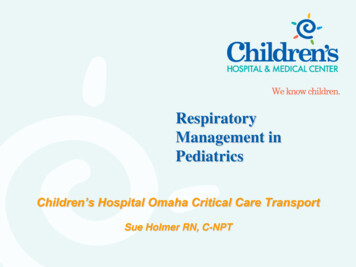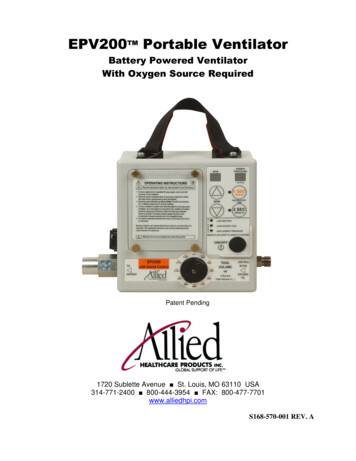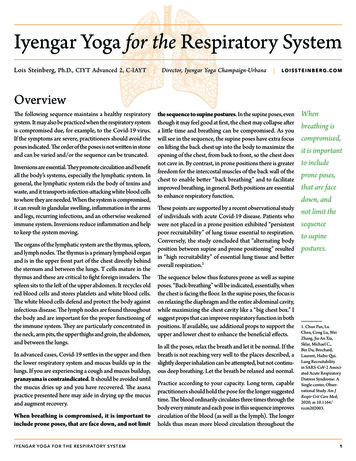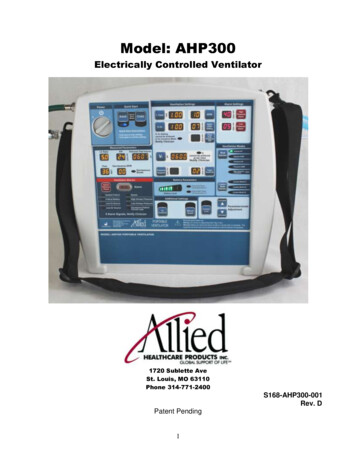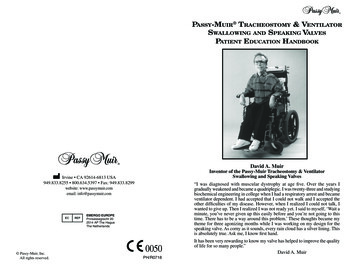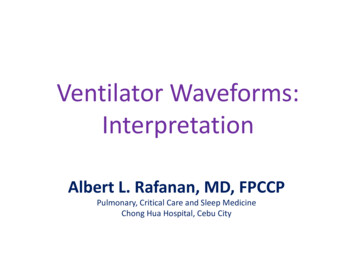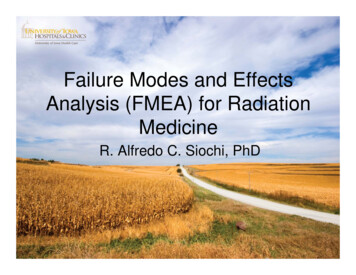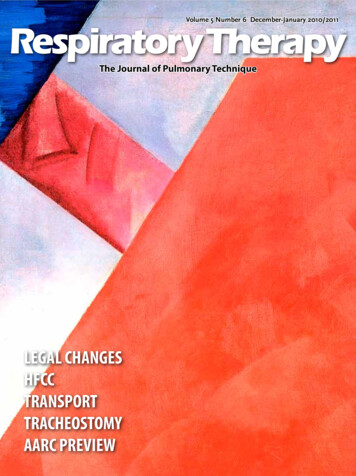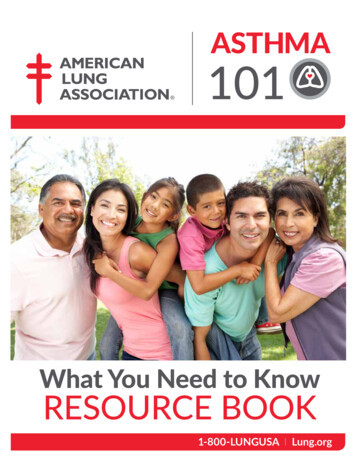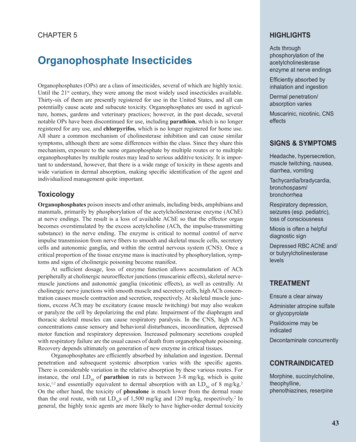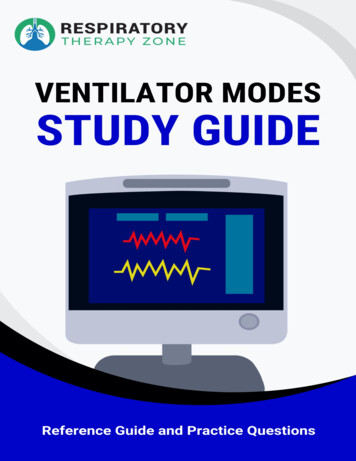
Transcription
Disclaimer:Medicine and respiratory therapy are continuously changingpractices. The author and publisher have reviewed all informationin this report with resources believed to be reliable and accurateand have made every effort to provide information that is up todate with the best practices at the time of publication. Despite ourbest efforts we cannot disregard the possibility of human errorand continual changes in best practices the author, publisher, andany other party involved in the production of this work canwarrant that the information contained herein is complete or fullyaccurate. The author, publisher, and all other parties involved inthis work disclaim all responsibility from any errors containedwithin this work and from the results from the use of thisinformation. Readers are encouraged to check all information inthis publication with institutional guidelines, other sources, and upto date information. Respiratory Therapy Zone is not affiliated withthe NBRC , AARC , or any other group at the time of thispublication.Copyright ã Respiratory Therapy Zone2
Table of ContentsIntroduction . . .4Primary Ventilator Modes . . . . .6Spontaneous Ventilator Modes . . . . .8Other Ventilator Modes . . . . .10Practice Questions . . . .16TMC Practice Questions . . . . .28Conclusion . . . .33References . . . . .34Copyright ã Respiratory Therapy Zone3
IntroductionAre you ready to learn about the modes of mechanical ventilation?I sure hope so because that is what this study guide is all about.Inside of this cheat sheet, we’ve listed out all the ventilator modesthat you need to know as a Respiratory Therapist or student.Not to mention, we’ve also included some helpful practicequestions as well.So if you’re ready to get started, let’s go ahead and dive right in. JFirst and foremost, let’s discuss what a ventilator mode even is.What is a Ventilator Mode?A ventilator mode is a way of describing how the mechanicalventilator assists the patient with inspiration. The characteristics ofa particular mode controls how the ventilator functions.Understanding the different ventilator modes is one of the mostimportant aspects of mechanical ventilation.Primary Control Variables:In mechanical ventilation, there are two primary control variables:1. Volume Control2. Pressure Control4
Volume ControlVolume Control means that you can set (or control) the patient’stidal volume.So with a set tidal volume and a set respiratory rate, this meansthat there is a known minute ventilation. This is good when itcomes to making adjustments to achieve a desired PaCO2.One of the negative aspects of using Volume Control is that, sincethe tidal volume is preset, if the patients lung compliance were todecrease, this could result in high peak pressures.Another drawback of Volume Control is patient-ventilatordyssynchrony.Pressure ControlPressure Control means that you can set (or control) the patient’spressure in order to achieve a desired tidal volume.As with Volume Control, a Pressure-Controlled tidal volume andset rate can help you reach a desired PaCO2.The main disadvantage of using Pressure Control is the patient’stidal volume can potentially be unstable if there are changes inthe patient’s lung compliance or airway resistance.So again, Volume Control and Pressure Control — those are thetwo control variables.When initiating mechanical ventilation on a patient, once youselect the control variable, now you can choose the actualoperational mode that determines the pattern of breathing for thepatient.5
Primary Ventilator ModesIn mechanical ventilation, there are two primary ventilator modes:1. Assist/Control (A/C) Mode2. Synchronous Intermittent Mandatory Ventilation (SIMV)ModeAssist/Control (A/C) ModeIn this mode, a minimum number of preset mandatory breathsare delivered by the ventilator but the patient can also triggerassisted breaths. The patient makes an effort to breathe and theventilator assists in delivering the breath.With that said, this mode of ventilation does not allow the patientto take spontaneous breaths. In this mode, the operator can seteither a controlled pressure or a controlled volume.The sensitivity control can be adjusted to make it easier or harderfor the patient to initiate a breath.When to Use Assist/Control?This mode is most often used when mechanical ventilation is firstinitiated for a patient because this mode provides full ventilatorysupport.That is also one of the advantages of using Assist/Control becauseit keeps the patient’s work of breathing requirement very low.One of the major complications of Assist/Control ishyperventilation, which results in respiratory alkalosis. This is theresult of too many breaths given to the patient, whether patienttriggered or machine-triggered.6
Synchronous Intermittent Mandatory Ventilation(SIMV) ModeIn this mode, the ventilator delivers a preset minimum number ofmandatory breaths. However, it also allows the patient to initiatespontaneous breaths in between the mandatory breaths.This mode also allows the operator to set either a controlledpressure or a controlled volume.When to Use SIMV?The primary indication for SIMV is when a patient needs partialventilatory support. That is because, since the patient can takesspontaneous breaths, that means they can contribute to some oftheir minute ventilation.SIMV is a mode that is used for weaning as well.Advantages of Using SIMV: Since the patient is able to take spontaneous breaths, it helpsto maintain their respiratory muscle strength and avoidmuscular atrophy. It distributes tidal volumes evenly throughout the lung fields,which reduces V/Q mismatching. It helps to decrease the patient’s mean airway pressure.As a Respiratory Therapist (or student), SIMV and Assist/Controlare the two ventilator modes that you should be most familiarwith.However, it’s also important to develop an understanding of thespontaneous modes and the secondary modes of mechanicalventilation as well.7
Spontaneous Ventilator ModesKeep in mind that, in order to use any of the following modes, thepatient must be breathing spontaneously.Continuous Positive Airway Pressure (CPAP)In CPAP, or continuous positive airway pressure, a continuouspressure that is above atmospheric pressure is maintainedthroughout the breathing cycle.The patient must be breathing spontaneously to be in this modebecause no mandatory breaths are given. This is a useful mode forweaning patients off of the ventilator.Pressure Support Ventilation (PSV)A mode of mechanical ventilation in which the patient’sspontaneous breaths are supported by the ventilator during theinspiratory phase of breathing. As the patient triggers a breath,the ventilator assists by adding pressure to make breathing easier.The level of pressure is preset by the operator, so you have controlover how much support you give the patient. For example, thehigher the level of pressure support that is set, the easier it will befor the patient to take a breath.In PSV, the breaths are time-cycled and pressure-limited.PSV is often used to help the patient overcome the airwayresistance that is caused by the endotracheal tube.8
For example, let’s say there is a patient who needs to be weanedfrom the ventilator that is in the SIMV mode. If their endotrachealtube size is too small, the airway resistance would be increasedwhich would make weaning difficult.That’s when PSV would come in handy to help the patientovercome the airway resistance so that they can be extubated.Volume Support (VS)A mode of mechanical ventilation in which the ventilator delivers asupported breath to help the patient reach a set tidal volume. Thismode is totally dependent on the patient’s effort, meaning that,the machine varies the inspiratory pressure support level witheach breath in order to achieve the target volume.This mode is not quite as common as some of the others, but it’soften used to wean patients from anesthesia.9
Other Ventilator ModesNow that we’ve covered the primary and spontaneous modes ofventilation, now let’s go through the unconventional ventilatormodes. These are sometimes referred to as the secondary modesof ventilation.1. Control Mode Ventilation (CMV)2. Airway Pressure Release Ventilation (APRV)3. Mandatory Minute Ventilation (MMV)4. Inverse Ratio Ventilation (IRV)5. Pressure Regulated Volume Control (PRVC)6. Proportional Assist Ventilation (PAV)7. Adaptive Support Ventilation (ASV)8. Adaptive Pressure Control (APC)9. Volume-Assured Pressure Support (VAPS)10. Neurally Adjusted Ventilatory Assist (NAVA)11. Automatic Tube Compensation (ATC)12. High-Frequency Oscillatory Ventilation (HFOV)Control Mode Ventilation (CMV)It’s a mode where the ventilator delivers a preset tidal volume at aset time-triggered frequency. Basically, the ventilator controlsboth the rate and tidal volume which means that it’s in totalcontrol of the minute ventilation.This mode should only be used on patients who are fully sedatedand have been administered neuromuscular blocking agents.That is also the biggest hazard of using this mode because, sincethe patient is fully dependent on the machine for ventilation andoxygenation, it could be devastating if they were to becomedisconnected.10
Airway Pressure Release Ventilation (APRV)A mode of mechanical ventilation in which two levels ofcontinuous positive airway pressure are applied with anintermittent release phase for spontaneous breaths. This mode isoften recommended to improve oxygenation and treat refractoryhypoxemia.Other indications for APRV include an Acute Lung Injury (ALI),Acute Respiratory Distress Syndrome (ARDS), and SevereAtelectasis.Settings for APRV: High PressureLow PressureHigh TimeLow TimeMandatory Minute Ventilation (MMV)This is a feature of some ventilators that causes an increase in themandatory breaths that are delivered when the patient’sspontaneous breathing level becomes inadequate.So basically, if the patient’s spontaneous breathing decreases, theventilator compensates in order to make sure that a safe minimalminute ventilation is delivered.MMV is often an additional function of the SIMV mode and isintended to prevent hypercapnia.11
Inverse Ratio Ventilation (IRV)This is a mode that uses an inverse I:E ratio to improveoxygenation and gas exchange. It’s been shown to decreaseshunting, improve V/Q mismatching, and decrease deadspaceventilation.IRV is commonly recommended for patients with AcuteRespiratory Distress Syndrome (ARDS).This mode causes auto-PEEP (intrinsic PEEP) which is actuallywhat helps improve the patient’s oxygenation and reduceshunting.Pressure Regulated Volume Control (PRVC)A mode of mechanical ventilation that provides volume-controlledbreaths with the lowest pressure possible. It does so by alteringthe flow and inspiratory time. This mode is used to keep the peakairway pressure at the lowest possible level.This mode is volume-cycled and can be patient triggered-or timetriggered.Proportional Assist Ventilation (PAV)This is a mode of mechanical ventilation where the machine usesvariable pressure to provide pressure support for a patient’sspontaneous breaths. The level of pressure support is adjusteddepending on the patient’s work of breathing.12
PAV is either pressure-triggered or flow-triggered, and thebreathing cycle ends once the patient’s volume or flow demandsare met.One thing to keep in mind about this mode is that, if the patient’slungs show rapid improvement, overdistention or barotraumacould occur because too much pressure would be delivered.Adaptive Support Ventilation (ASV)A mode of ventilation that changes the number of mandatorybreaths and pressure support level according to the patient’sbreathing pattern.Adaptive Pressure Control (APC)A pressure-controlled mode that utilizes a closed-loop control ofthe pressure setting in order to maintain a minimum deliveredtidal volume.With that said, in this mode, the delivered tidal volume will varydepending on the patient’s lung compliance.Volume-Assured Pressure Support (VAPS)A mode of ventilation that provides a stable tidal volume byincorporating inspiratory pressure support ventilation along withconventional volume-assisted cycles. It’s only available on certainventilators.13
This mode can cause a prolonged inspiratory time, so patientswith an obstructive disease should be monitored closely in orderto prevent air trapping or other cardiovascular effects.Neurally Adjusted Ventilatory Assist (NAVA)A ventilator mode that uses the patient’s electrical activity of thediaphragm to guide the functionality of the ventilator.A catheter with electrodes is positioned in the patient’s esophagusat the level of the diaphragm, and that is how the electrical activityis picked up from the phrenic nerves. Then, the ventilator uses thisinformation to ventilate the patient.Automatic Tube Compensation (ATC)While not technically a ventilator mode, this is a setting on someventilators that offsets and compensates for the airflow resistancethat is imposed by the endotracheal tube or artificial airway.High-Frequency Oscillatory Ventilation (HFOV)A type of mechanical ventilation that delivers very small tidalvolumes at an extremely fast rate which minimizes the chances ofa lung injury.This mode has been shown to improve oxygenation in severecases, such as with refractory hypoxemia.14
Adjusting the Setting in HFOV: Ventilation – can be increased by increasing the Amplitude(Power) or by decreasing the frequency. Ventilation – can be decreased by decreasing the Amplitude(Power) or by increasing the frequency. Oxygenation – can be increased by increasing the MeanAirway Pressure setting or by increasing the FiO2. Oxygenation – can be decreased by decreasing the MeanAirway Pressure setting or by decreasing the FiO2.This mode is also indicated to provide mechanical ventilatorysupport in neonates with conditions such as congenitaldiaphragmatic hernia, diffuse alveolar disease, and pulmonaryhypoplasia.15
Practice Questions:1. What are 5 examples of ventilator modes?CMV, A/C, IMV, SIMV, and CPAP2. What type of pressure ventilation involves normal respirations,chest cuirass, and an iron lung?Negative pressure3. Positive pressure ventilators can be vs controlled.Pressure, Volume4. What are 2 example of nonconventional ventilator modes?HFOV and APRV5. How does positive pressure ventilation create transairwaypressure?By increasing airway opening pressure above the alveolarpressure.6. List the modes of positive pressure ventilation from the mostsupport to the least support:CMV, A/C, IMV, SIMV, CPAP7. What is an advantage of a volume-controlled mode?It ensures minimal minute ventilation.8. What are some disadvantages of a volume-controlled modes?The pressure is variable, there is a possibility ofbarotrauma/volutrauma, and the volume is limited by the highpressure alarm.9. What is an advantage of a pressure-limited mode?There is less risk of barotrauma.10. What are some disadvantages of pressure-controlled modes?16
It doesn’t ensure minute ventilation, and the tidal volume isvariable.11. What two things are variable in pressure-controlled modes?Volume (dependent on a set pressure) and Flow.12. What are the four types of triggers?Time, Patient, Pressure, and Flow.13. What control is used to adjust the patient’s inspiratory effort?Sensitivity14. What are the two types of sensitivity controls?Pressure and Flow15. How does a pressure trigger work?The ventilator senses a drop in pressure below the baseline andsenses the patient’s negative inspiratory effort.16. Which trigger type is more sensitive, pressure or flow?Flow17. How does a flow trigger work?When a patient initiates a breath, base flow returning to theventilator is reduced, thus triggering an inspiration.18. What is Controlled Mandatory Ventilation?A mode that is time-triggered, gives machine breaths, and isvolume or pressure cycled.19. What are the indications for CMV?The need to control minute ventilation completely. Also, the needto control chest expansion completely, for example, for a patientwith flail chest.20. What are some complications of CMV?17
The patient is totally ventilator dependent, alarms are essential,you may be unable to assess weaning, and seizures may interruptthe delivery of a breath.21. What are some indications for A/C mode?The patient needs full ventilatory support, the need to support ahigh minute ventilation with low oxygen consumption, and theneed for sedation after intubation.22. What are some advantages of A/C mode?Decreased work of breathing. The patient controls the respiratoryrate, therefore the minute ventilation.23. What are some complications of A/C mode?Hyperventilation (i.e., respiratory alkalosis), pain/anxiety/CNSdisease, Biot’s or Cheyne-stokes respirations.24. What is the IMV mode?It was the first widely used mode that allowed partial ventilatorysupport, facilitates weaning, and increases respiratory musclestrength. It is not widely used today.25. What are some complications of IMV?Breath stacking, which is a spontaneous effort immediatelyfollowed by a mechanical breath, which leads to an increased PIP;barotrauma; and cardiac compromise.26. What is barotrauma/volutrauma?A lung injury that occurs from hyperinflation of the alveoli past therupture point. It usually occurs at a PIP 50 and a Pplat 35.27. What is the synchronization window?It is the time interval just prior to time triggering in which theventilator is responsive to the patient’s spontaneous breath.28. What are some indications for SIMV?18
If the patient needs partial ventilatory support, and if the patientcan actively contribute to their minute ventilation.29. What happens if the rate is set high in SIMV mode?This can provide total support (SIMV with no spontaneous rate isessentially the same as A/C)30. What happens if the rate is set low in SIMV mode?It facilitates weaning, strengthens respiratory muscles, decreasesmean airway pressure making spontaneous breaths have a lowerpeak pressure than mandatory.31. What are some complications of SIMV?A low rate can increase the patient’s work of breathing causingmuscle fatigue/failure.32. What mode has a positive baseline pressure continuouslyapplied to the circuit and airway during both inspiration andexpiration?CPAP33. In this mode, the ventilator delivers a time-triggered breathand allows the patient to breathe at their own tidal volumebetween mechanical breaths?SIMV34. In this mode, the ventilator delivers a set tidal volume orpressure at a time-triggered rate but the patient can trigger amechanical breath above the preset rate?Assist/Control35. In this mode of ventilation, the patient cannot trigger amechanical or spontaneous breath so there is no negativedeflection on graphics?Controlled Mandatory Ventilation (CMV). The patient must besedated or paralyzed. It is not as commonly used.19
36. In order for this mode to be used, the patient must bespontaneously breathing, have adequate lung function tomaintain normal PaCO2, and not be at risk for hypoventilation?CPAP37. What does pressure support do?It augments spontaneous tidal volume, decreases spontaneousrespiratory rate, and reduces the patient’s work of breathing.38. How does pressure support decrease the patient’sspontaneous respiratory rate?An increased volume decreases the need for a high respiratoryrate in order to achieve the required minute ventilation. Also, itdecreases deadspace ventilation.39. What is the desired respiratory rate?Less than 25.40. What is tidal volume dependent upon with a pressure supportmode?It is dependent on the set inspiratory pressure, lung compliance,and airway resistance.41. What makes flow variable in pressure support?It’s dependent upon the flow needed to maintain the plateaupressure.42. What would be considered CPAP with pressure support?BiPAP43. CPAP with no pressure support would be considered what?CPAP44. How do you manage pressure support?Begin with 5-10 and increase in increments of 3-5.20
45. You should titrate pressure support according to what 3things?(1) Spontaneous tidal volume of 5 – 7 ml/kg of IBW. (2) Respiratoryrate of less than 25. (3) A decrease in work of breathing.46. Is PEEP considered a standalone mode on ventilation?No47. What are some effects of PEEP?They recruit alveoli, increase FRC (oxygenation), increase alveolarsurface area (gas diffusion), and increase compliance.48. What are some complications of PEEP?Cardiac compromise, increased intrathoracic pressure, decreasedvenous return, decreased cardiac output and blood pressure.49. What is an indication for PEEP?Refractory hypoxemia50. How do you manage PEEP?The physiologic normal setting of PEEP is 5 cmH2O. Then you canincrease in increments of 3 – 5 while also watching the patient’sblood pressure. You should decrease to the previous level or zeroto lower blood pressure. You can treat low blood pressure withvolume expansion or vasopressors, then increase PEEP againwhile continuing to monitor.51. What is the definition of compliance?It is the volume change per unit of pressure.52. Inverse ratio ventilation is volume controlled or pressurecontrolled?Pressure controlled53. During breathing, a long inspiration and a short expirationcauses what?21
Air trapping, auto PEEP, and prevents alveolar collapse.54. What is Auto-PEEP?Air trapping that occurs when there is an incomplete expiration.55. How does IRV prevent alveolar collapse?The critical opening pressure is reduced, the pressure needed forventilation is less, and it improves ventilation.56. What are some complications of IRV?Barotrauma, requires paralysis sedation, and cardiovascularcompromise.57. When is mandatory minute ventilation activated?When the patient’s spontaneous breathing is less than minimumset minute ventilation. When this occurs, the ventilator increasesventilation.58. The method of increased ventilation with MMV varies uponwhat?The ventilator model (some increases respiratory rate, some tidalvolume, and some pressure support).59. What should the minute ventilation be set to achieve?A satisfactory PaCO260. What are some advantages of MMV?It promotes spontaneous breathing, it requires minimal supportbut protects against hypoventilation and respiratory acidosis, andit permits weaning but compensates for apnea.61. What are some disadvantages and complications of MMV?It doesn’t protect against deadspace breathing. A high respiratoryrate with a low tidal volume means the patient is breathing aboveminute ventilation (MMV remains inactive but PaCO2 increases,respiratory acidosis).22
62. What does pressure control generate?A flow in order to increase the airway pressure to a preset pressurelimit.63. When is inspiration terminated in Pressure Control?When the preset I-Time is reached.64. What are some indications for pressure control?Low lung compliance, high PIP during volume ventilation, (PIP 50, Pplat 35), and ARDS.65. What are some advantages of pressure control?PIP is reduced while maintaining adequate oxygenation andventilation. Also, there is a reduced risk of barotraumas.66. How do you manage pressure control?The PIP is set to achieve a desired tidal volume unless the patientis allowed to become hypercapnic in the interest of limiting PIP.Tidal volume and minute ventilation must be carefully monitored.67. What is APRV?A mode of ventilation that stands for: Airway Pressure ReleaseVentilation.68. What happens during inspiration in APRV?Positive airway pressure augments spontaneous breathing (HighCPAP level, reduces WOB, Increases MAP to increase O2, allowsspontaneous inspiration at any point during the breath-elevatedpressure delivery).69. What happens during exhalation with APRV?Positive pressure is periodically released to allow exhalation (brief 1– 2 seconds), decreases FRC and allows for exhalation and therelease of CO2.70. APRV is inappropriate for what kind of patients?23
Those at risk for an inadequate spontaneous respiratory rate.71. APRV can resemble IRV when?The expiratory pressure release time is less than the spontaneouseffort.72. Why is APRV a beneficial alternative to IRV?Because it does not require paralytics.73. Describe APRV:It is time-triggered but the patient is allowed to breathespontaneously at any time; it is mandatory and spontaneouspressure limited; it is time-cycled with a preset I-time.74. Describe HFOV:It reduces the risk of lung destruction by keeping alveoli open at aconstant pressure, oscillates very rapidly (high respiratory rate atsmall volumes); early intervention is key.75. How do you manage oxygenation with HFOV?Adjust the mean airway pressure, FiO2, and alveolar recruitment.76. How do you manage ventilation with HFOV?Adjust the amplitude, Hertz, % I-time, cuff deflation, andpermissive hypercapnia.77. What is Amplitude in HFOV?It is the change in stroke volume and the force delivered by thepiston.78. What are the trigger variables for VC/AC CMV?Pressure, time, and flow79. What are the limit variables for VC/AC CMV?Volume and flow24
80. What are the targeted variables for VC/AC CMV?Volume81. What are the cycle variables for VC/AC CMV?Volume82. What are the trigger variables for VC/SIMV?Time, volume, and pressure83. What are the limit variables for VC/SIMV?Volume84. What is Controlled Mandatory Ventilation (CMV)?It is used in sedated, apneic, or paralyzed patients. All breaths aretriggered, limited, and cycled by the ventilator. The patient has noability to initiate their own breaths. If a patient tries to take abreath while in the CMV mode it is reported to sound like suckingon an empty bottle.85. What is Synchronized Intermittent Mandatory Ventilation(SIMV)?It is an assisted mechanical ventilation synchronized with thepatient’s breathing. The ventilator senses the patient taking abreath then delivers the breath. Spontaneous breathing by patientoccurs between the assisted mechanical breaths which occurs atpreset intervals. If the patient fails to take a breath, the ventilatorwill provide a mechanical breath.86. When is SIMV preferred?When the patient has an intact respiratory drive.87. How is SIMV is similar to CPAP and BIPAP?Because they are all spontaneously triggered by patient.88. How does Assist/Control Ventilation work?25
The trigger for delivery of a breath can be either by the patient orby elapsed time.89. What is the preferred mode for patients with respiratorydistress?Assist/Control Ventilation90. What mode supports every breath whether its initiated by thepatient or ventilator. Also, this mode delivers a full tidal volumeregardless of the patient’s respiratory effort or drive?Assist/Control Ventilation91. This mode can be used in ARDS, paralyzed, or sedatedpatients?Assist/Control Ventilation92. During Assist/Control ventilation, what can happen to ananxious patient?They can trigger the ventilator to hyperventilate which leads tobreath stacking or auto-PEEP.93. Which mode of mechanical ventilation can provide a preciseI:E ratio?Control Mode Ventilation (CMV)94. What mode can make it easier for the patient to overcome theresistance of the ET tube and is often used during weaningbecause it reduces the work of breathing?Pressure Support Ventilation95. Describe Pressure Support Ventilation:It supports ventilation during inspiration. The patient determinestidal volumes, rate, and minute volume. It requires consistentrespiratory effort by the patient.96. What is a component of CPAP/BPAP?26
They are both spontaneously triggered by the patient.97. What does CPAP stand for?Continuous Positive Airway Pressure98. What mode uses continuous positive pressure to maintain acontinuous level of PEEP and uses mild air pressure to keep theairway open?CPAP99. What does BiPAP stand for?Bilevel Positive Airway Pressure100. What mode uses alternating levels of PEEP to maintainoxygenation, commonly used in pneumonia, COPD, and asthma?BiPAP27
TMC Practice Questions:As a bonus, we wanted to give you access to a few sample TMCPractice Questions on the topic of mechanical ventilation.1.A 63-year-old female patient is intubated and receivingmechanical ventilation in the pressure controlled A/C mode. Ifthe patient’s compliance were to decrease, which of thefollowing would you expect to occur?A. Her delivered volume will decreaseB. Her peak pressure will increaseC. Her inspiratory time will increaseD. Her PEEP level will decreaseTo get this one correct, you must have a basic understanding oflung compliance. You also have to take into account that theventilator is in the pressure control mode, which means that thepressure is pre-set.If there is a decrease in lung compliance when the ventilator isoperating in the pressure control mode, the machine will continuedelivering a constant pressure. But, since the lungs don’t expandas much when there is decreased compliance, it reaches the setpressure limit much faster. That means that there will be adecrease in the delivered tidal volume.In this case, the inspiratory time will decrease and the PEEP levelsshould not be affected.The correct answer is: A. Her delivered volume will decrease28
2.A 176 lb male patient is intubated and receiving volume controlA/C ventilation with the following settings: FiO2 of 40%, Rate of12/min, and Tidal Volume of 550 mL. An ABG was analyzed andthe following results were obtained:ABG ResultspH 7.39PaCO2 37 mmHgHCO3- 23 mEq/LPaO2 107 mmHgVentilator SettingsSpontaneous Tidal Volume 180 mLSpontaneous Rate 37/minVital Capacity 550 mLMIP/NIF -12 cm H2OWhich of the following would you recommend?A. Place the patient on a 40% T-piece and monitor closelyB. Switch the patient to SIMV at a rate of 5/minuteC. Place the patient CPAP and monitor closelyD. Maintain the current ventilator
Respiratory Therapy Zone is not affiliated with . I sure hope so because that is what this study guide is all about. Inside of this cheat sheet, we’ve listed out all the ventilator modes that you need to know as a Respiratory Therapist or student. Not
